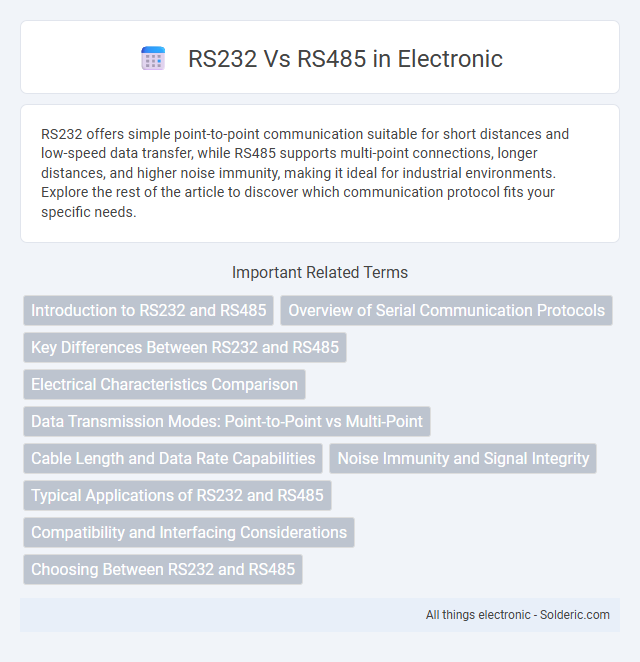RS232 offers simple point-to-point communication suitable for short distances and low-speed data transfer, while RS485 supports multi-point connections, longer distances, and higher noise immunity, making it ideal for industrial environments. Explore the rest of the article to discover which communication protocol fits your specific needs.
Comparison Table
| Feature | RS232 | RS485 |
|---|---|---|
| Communication Type | Point-to-point | Multi-point (up to 32 devices) |
| Signal Levels | +-12V (single-ended) | Differential +-5V |
| Max Cable Length | 15 meters (approx.) | 1200 meters (4000 feet) |
| Data Rate | Up to 115.2 kbps | Up to 10 Mbps (short distances) |
| Noise Immunity | Low | High (differential signaling) |
| Wiring | 3 to 9 wires | 2 wires (twisted pair) |
| Use Case | Short-distance, simple serial communication | Industrial, long-distance, multi-device networks |
Introduction to RS232 and RS485
RS232 and RS485 are serial communication standards widely used for data exchange between electronic devices. RS232 supports point-to-point communication with voltage levels suitable for short-distance transmissions up to 15 meters, commonly used for computer serial ports and modem connections. RS485 enables multi-point communication on a differential bus, supporting longer distances up to 1,200 meters and higher noise immunity, making it ideal for industrial automation and control systems.
Overview of Serial Communication Protocols
RS232 and RS485 are common serial communication protocols used for data transmission between devices, with RS232 supporting point-to-point connections and RS485 enabling multipoint networks. RS232 typically operates at shorter distances up to 15 meters with single-ended signaling, while RS485 allows longer distance communication up to 1200 meters using differential signaling for noise immunity. These protocols differ in voltage levels, wiring complexity, and their ability to handle multiple devices on a shared bus.
Key Differences Between RS232 and RS485
RS232 supports point-to-point communication with a single transmitter and receiver, while RS485 enables multi-point communication allowing multiple devices on the same bus. RS232 uses unbalanced signaling over shorter distances (up to 15 meters), whereas RS485 employs differential signaling, providing greater noise immunity and longer range (up to 1200 meters). Your choice depends on system requirements like distance, device count, and noise environment, with RS485 preferred for industrial networks and RS232 for simple, short-distance connections.
Electrical Characteristics Comparison
RS232 operates with single-ended signaling and voltage levels typically ranging from +-3V to +-15V, which limits its communication distance to about 15 meters and supports lower data rates. RS485 uses differential signaling with balanced line drivers, enabling it to achieve longer communication distances up to 1200 meters and support data rates up to 10 Mbps by minimizing noise and signal degradation. The differential nature of RS485 provides superior noise immunity and allows multiple devices (up to 32 nodes) to share the same bus, unlike the point-to-point configuration of RS232.
Data Transmission Modes: Point-to-Point vs Multi-Point
RS232 supports point-to-point data transmission, enabling direct communication between two devices with simple wiring and low noise immunity, suitable for short distances up to 15 meters. RS485, on the other hand, facilitates multi-point communication with up to 32 devices on a single bus, making it ideal for longer distances up to 1200 meters and environments requiring robust noise resistance. Your choice between RS232 and RS485 depends on the network size and communication complexity needed for your application.
Cable Length and Data Rate Capabilities
RS232 supports cable lengths up to 15 meters (50 feet) with data rates typically maxing out at 115.2 kbps, making it suitable for short-distance communication. RS485 can extend cable lengths up to 1,200 meters (4,000 feet) while maintaining higher data rates, often reaching 10 Mbps depending on the cable quality and network configuration. The differential signaling in RS485 enhances noise immunity over long distances, enabling robust data transmission in industrial environments compared to the single-ended RS232 standard.
Noise Immunity and Signal Integrity
RS485 offers superior noise immunity compared to RS232 by utilizing differential signaling, which reduces the impact of electromagnetic interference and enhances signal integrity over longer distances up to 1,200 meters. RS232 uses single-ended signaling, making it more susceptible to noise and signal degradation, limiting reliable communication typically to 15 meters. The balanced transmission in RS485 ensures stable data transfer in electrically noisy environments, making it ideal for industrial automation and control systems.
Typical Applications of RS232 and RS485
RS232 is commonly used in short-distance communication such as connecting computers to peripherals like modems, printers, and industrial equipment due to its simple point-to-point configuration and low cost. RS485 excels in industrial automation, building management systems, and long-distance data transmission environments where multiple devices communicate over a single bus with high noise immunity and differential signaling. Both interfaces support serial communication but are selected based on communication distance, network complexity, and environmental conditions.
Compatibility and Interfacing Considerations
RS232 supports point-to-point communication with limited cable length and is compatible with most PCs and serial devices, making it simpler to interface for short-distance applications. RS485 allows multi-point connections over longer distances and is ideal for industrial environments requiring noise resistance and multiple device networking. When integrating Your system, consider that RS232 uses single-ended signaling while RS485 employs differential signaling, affecting compatibility and requiring proper transceivers for effective interfacing.
Choosing Between RS232 and RS485
Choosing between RS232 and RS485 depends on your communication distance and environment requirements. RS232 supports point-to-point communication up to 50 feet, ideal for short, simple setups, while RS485 enables multi-point connections over distances up to 4,000 feet in noisy industrial environments. Your decision should prioritize the number of devices and the level of signal interference in your application.
RS232 vs RS485 Infographic

 solderic.com
solderic.com